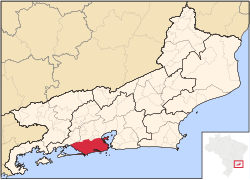Guanabara (state)
State of Guanabara | |
|---|---|
Former State | |
 Location of the state of Rio de Janeiro (light yellow) and the now-defunct state of Guanabara (red) in Brazil. | |
| Coordinates: 22°54′S 43°11′W / 22.900°S 43.183°W | |
| Country | |
| Established | 1960 |
| Dissolved | 1975 |
| Capital | Rio de Janeiro |
| Government | |
| • Governor | Antônio de Pádua Chagas Freitas (last governor, 1971–75) |
| Area | |
• Total | 1,356 km2 (524 sq mi) |
| Population | |
• Estimate (1975) | 4,858,000 |
| Demonym(s) | carioca (by city) and guanabarino(a)1 (by state) |
| Time zone | UTC-3 (BRT) |
| • Summer (DST) | UTC-2 (BRST) |
| ISO 3166 code | BR-GB |
| ^1 Mostly used in official documents | |
The State of Guanabara (Template:Lang-pt, IPA: [ɡwanaˈbaɾa]) was a Brazilian state that existed from 1960 to 1975 in the territory of the current municipality of Rio de Janeiro. In your area, it was located the old Federal District. The Guanabara word has its origin in Tupi guaná-pará, meaning within seas.
In 1834, the city of Rio de Janeiro was elevated to Imperial capital of the Empire of Brazil, but it was not part of any Brazilian province, having special status as the so-called Neutral Municipality (Template:Lang-pt). The surrounding Province of Rio de Janeiro (which did not include the city) had its capital city in Niterói. When Brazil became a republic in 1889, the city of Rio de Janeiro remained the national capital and it was located in the Federal District (Template:Lang-pt), while the surrounding homonymous province became a state, still with Niterói as its capital.
When the national capital was moved to Brasília in 1960, a new Federal District , separate from the state of Goiás and the border with the state of Minas Gerais to contain it, and the old Federal District became the state of Guanabara.
Throughout its 15-year existence, Guanabara was a unique state in many ways. Comprising only one city (albeit a large one), Guanabara was the smallest Brazilian state by land. It also had the peculiarity of being the only Brazilian state that was not divided into municipalities. Although for some practical purposes, it was sometimes counted as having one single municipality, and Rio de Janeiro was officially named its capital, there was no mayor, municipal legislature or any other municipal government institution there, as the city of Rio de Janeiro was directly administered by the state government. On the other hand, that also meant that the Guanabara state government had some functions that were normally assigned to municipalities elsewhere, such as regulating urban zoning, inspecting the safety of buildings, or issuing licenses for commercial venues, for example.
All the characteristics disappeared in 1975, when the state of Guanabara merged into a the state of Rio de Janeiro. With the merge, the capital of the state of Rio de Janeiro was transferred back from city of Niterói to city of Rio de Janeiro, as it was until 1834 when the empire created the Neutral Municipality.
See also


